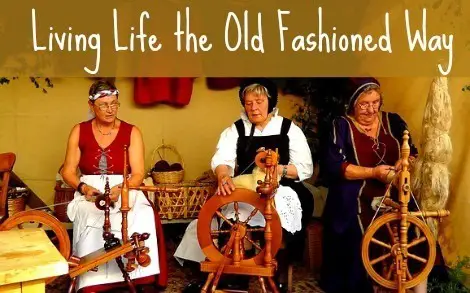27th October 2014
By Gaye Levy
Contributing Writer for Wake Up World
There is a tendency in all of us to compare the old to the new. This is especially true in the preparedness community where in anticipation of potential hard times ahead, we look to our parents and grandparents for ideas for living a self-reliant and sustainable life. I have been thinking about that a lot lately, even to the extent that I have considered sewing up some long skirts and pioneer-style aprons that will hold up to a week or two of wear without laundering. Seriously.
Anyway, the following piece has been circulating for a while. I thought it was worth bringing back since it describes a time not so long ago when the term “green” referred to the color of your grass or the money in your pocket. As I was reading these words, it occurred to me that many of these old-fangled ways of doing things fall right in line with what each of us would be required to do in a crisis or emergency, or find ourselves with limited sources of power and food, few goods available on the shelves, and a cost of living so high that there was little left for discretionary spending.
Perhaps it is time to redefine “green” and “sustainable” using old-fashioned terms.
Here are the Old-Fashioned, Old Fogey Rules of Sustainability (author unknown).
[pro_ad_display_adzone id=”110028″]
Living Life the Old Fashioned Way
“In the line at the store, the cashier told the older woman that she should bring her own grocery bag because plastic bags weren’t good for the environment. The woman apologized to him and explained, “We didn’t have the green thing back in my day”.
The clerk responded, “That’s our problem today. The former generation did not care enough to save our environment.”
He was right, that generation didn’t have the green thing in its day. Back then, they returned their milk bottles, soda bottles and beer bottles to the store. The store sent them back to the plant to be washed and sterilized and refilled, so it could use the same bottles over and over. So they really were recycled.
But they didn’t have the green thing back in that customer’s day. In her day, they walked up stairs, because they didn’t have an escalator in every store and office building. They walked to the grocery store and didn’t climb into a 300-horsepower machine every time they had to go two blocks.
But she was right. They didn’t have the green thing in her day.
Back then, they washed the baby’s diapers because they didn’t have the throw-away kind. They dried clothes on a line, not in an energy gobbling machine burning up 220 volts – wind and solar power really did dry the clothes. Kids got hand-me-down clothes from their brothers or sisters, not always brand-new clothing. But that old lady is right; they didn’t have the green thing back in her day.
Back then, they had one TV, or radio, in the house – not a TV in every room. And the TV had a small screen the size of a handkerchief, not a screen the size of the state of Montana. In the kitchen, they blended and stirred by hand because they didn’t have electric machines to do everything for them.
In summer, they slept with the windows open, perhaps even out on sleeping porches, because most homes and apartments lacked air conditioning. Some people still live in those archeological relics in most cities today. When they packaged a fragile item to send in the mail, they used a wadded up old newspaper to cushion it, not Styrofoam or plastic bubble wrap.
Back then, they didn’t fire up an engine and burn gasoline just to cut the lawn. They used a push mower that ran on human power. They exercised by working so they didn’t need to go to a health club to run on treadmills that operate on electricity. But she’s right; they didn’t have the green thing back then.
They drank from a fountain when they were thirsty instead of using a cup or a plastic bottle every time they had a drink of water. They refilled their writing pens with ink instead of buying a new pen, and they replaced the razor blades in a razor instead of throwing away the whole razor just because the blade got dull. But they didn’t have the green thing back then.
Back then, people took the streetcar or a bus and kids rode their bikes to school or rode the school bus instead of turning their moms into a 24-hour taxi service. They had one electrical outlet in a room, not an entire bank of sockets to power a dozen appliances. And they didn’t need a computerized gadget to receive a signal beamed from satellites 2,000 miles out in space in order to find the nearest pizza joint.
But isn’t it sad the current generation laments how wasteful the old folks were just because they didn’t have the green thing back then?”
The Final Word
Enjoy your next adventure through sustainability, common sense and thoughtful preparation!
Gaye
Further articles by Gaye Levy:
- Using Nature’s Remedies for Health and Wellness
- 20 All Purpose Remedies Using Essential Oils
- The Powerful Healing Qualities of Rosemary Essential Oil
- 15 Alternative Uses for Honey
- Vermiculture: How To Build A Worm Bin the Cheap and Easy Way
- Spices for the Survival Pantry
- 21 Home Remedies for a Toothache Emergency
- The Miracle of Tea Tree Oil: 80 Amazing Uses for Survival
- 26 Five-Minute Prepping Projects
- 10 Simple Steps Toward Self-Sufficiency
- Creating a Healing Garden: 9 Healing Herbs You Can Grow Yourself
About the author:
 Gaye Levy, also known as the Survival Woman, grew up and attended school in the Greater Seattle area. After spending many years as an executive in the software industry, she started a specialized accounting practice offering contract CFO work to emerging high tech and service industries. She has now abandoned city life and has moved to a serenely beautiful rural area on an island in NW Washington State.
Gaye Levy, also known as the Survival Woman, grew up and attended school in the Greater Seattle area. After spending many years as an executive in the software industry, she started a specialized accounting practice offering contract CFO work to emerging high tech and service industries. She has now abandoned city life and has moved to a serenely beautiful rural area on an island in NW Washington State.
Gaye lives and teaches the principles of a sustainable and self-reliant lifestyle through her website at BackdoorSurvival.com. At Backdoor Survival, she speaks her mind and delivers her message of prepping with optimism and grace, regardless of the uncertain times and mayhem swirling around us. You can find Gaye through her website Backdoor Survival.com, on Facebook, Twitter and Pinterest.
If you have not done so already, please be sure to like Gaye’s Facebook page, which is updated every time there is an awesome new article, news byte, or link to a free survival, prepping or homesteading book on Amazon. In addition, when you sign up to receive Gaye’s email updates you will receive a free, downloadable copy of her e-book The Emergency Food Buyer’s Guide.
[pro_ad_display_adzone id=”110027″]







